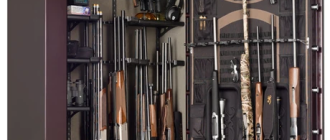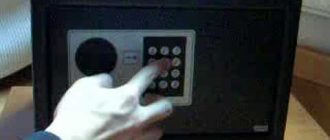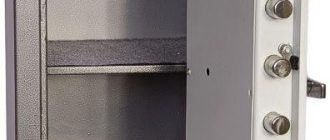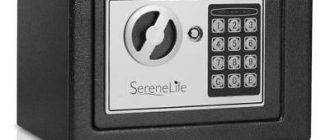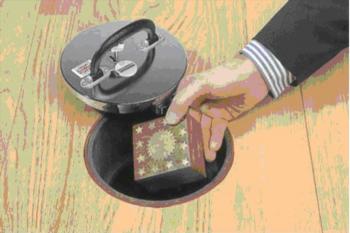
How to install a floor safe
When it comes to keeping your valuables safe and secure, a floor safe can be an excellent choice. Floor safes are discreet and can be easily hidden beneath your flooring, providing an extra layer of protection for your possessions. But how exactly do you go about installing a floor safe?
In this step-by-step guide, we will walk you through the process of installing a floor safe, from choosing the right location to securing it in place. Our expert tips will help ensure that your floor safe is installed correctly and securely, providing you with peace of mind.
Firstly, you will need to consider the ideal location for your floor safe. This should be a spot that is easily accessible to you but not easily visible to others. Additionally, you will want to choose a location that does not interfere with any plumbing or electrical lines beneath your flooring.
Overview of Floor Safes
A floor safe is a secure storage option that is installed directly into the floor of a building. It provides a convenient and discreet way to store valuables, such as cash, jewelry, important documents, and firearms.
Installing a floor safe is a great way to protect your valuables from theft and fire damage. It can also provide peace of mind knowing that your belongings are securely stored away and out of sight.
Before you begin the installation process, there are several factors to consider. First, you need to select the right type and size of floor safe for your needs. It is important to choose a safe that is made of high-quality materials and equipped with a reliable locking mechanism.
Next, you will need to determine the best location for your floor safe. Ideally, it should be installed in a hidden and easily accessible area. You may also want to consider installing the safe in a place where it can be covered with a rug or furniture to further conceal its presence.
Once you have chosen the location, you will need to prepare the floor for installation. This may involve cutting through the floor and creating a space for the safe to fit snugly into. It is important to follow the manufacturer’s instructions carefully to ensure proper installation.
During the installation process, it is recommended to seek professional assistance, especially if you are not familiar with construction or have never installed a floor safe before. A professional can help ensure that the safe is installed securely and correctly.
To summarize, installing a floor safe is a practical and effective way to protect your valuable possessions. By choosing the right safe, selecting a suitable location, and following the proper installation process, you can enjoy the added security and peace of mind that a floor safe provides.
What is a Floor Safe?
A floor safe is a type of safe that is installed directly into the floor of a building or home. It is designed to be hidden from view, offering a higher level of security compared to other types of safes. Floor safes are typically made of heavy-duty materials such as steel and are installed flush with the floor surface, making them difficult to detect and access.
Due to their installation method, floor safes are considered to be one of the most secure options for storing valuables such as cash, documents, and jewelry. They are particularly popular in commercial settings, such as banks and jewelry stores, where high-security measures are necessary.
Installing a floor safe requires careful planning and expertise. It involves cutting a hole in the floor, ensuring proper alignment and leveling, and securing the safe in place. The process can be complex and time-consuming, so it is recommended to hire a professional to ensure the safe is installed correctly and securely.
When choosing a floor safe, consider factors such as the size, locking mechanism, and fire rating. It is essential to select a safe that meets your specific security needs and provides adequate protection for your valuables.
In conclusion, a floor safe is a secure option for storing valuables. It is installed directly into the floor and offers a hidden and robust storage solution. Proper installation and selecting the right safe are crucial to ensure maximum security and protection for your belongings.
Importance of Installing a Floor Safe
Installing a floor safe is an essential step for ensuring the security of your valuable possessions. By installing a floor safe, you can have peace of mind knowing that your belongings are protected from theft or unauthorized access.
One of the main advantages of installing a floor safe is its concealment. Unlike a wall safe or a freestanding safe, a floor safe is hidden in the floor, making it extremely difficult for burglars to locate and access. This added level of security makes it an ideal choice for storing cash, jewelry, important documents, and other valuable items.
Another benefit of installing a floor safe is its resistance to fire and water damage. Floor safes are designed to withstand high temperatures and offer a certain level of protection to their contents even in case of a fire. Additionally, they are usually waterproof, providing an extra layer of protection against water damage.
Furthermore, floor safes are usually made of durable materials such as steel, making them highly resistant to physical attacks. They typically have thick doors and secure locking mechanisms, making it extremely difficult for burglars to break into them.
In addition to their security features, floor safes are also convenient and easily accessible. Once installed, they can be hidden under furniture or a rug, blending seamlessly into your home or office environment. This allows you to have quick and easy access to your valuables whenever you need them.
| Overall, installing a floor safe offers the following benefits: |
| – Concealment |
| – Resistance to fire and water damage |
| – Durability and resistance to physical attacks |
| – Convenience and easy accessibility |
Choosing the Right Floor Safe
When it comes to selecting a floor safe, it is important to consider several factors to ensure that you choose the right one for your needs. Here are some key points to consider:
| Material | Consider the material that the floor safe is made of. Look for a safe that is constructed from durable and tamper-resistant materials such as steel. |
| Size | Determine the size of the floor safe based on the items you plan on storing inside. Consider the dimensions and ensure that it will fit in the desired location. |
| Security Features | Look for security features that will protect your valuables. Features such as a locking mechanism, pry-resistant door, and fire-resistant construction can provide added security. |
| Installation | Consider how the floor safe will be installed. Some safes may require professional installation, while others can be easily installed by following step-by-step instructions. |
| Budget | Set a budget for your floor safe purchase and stick to it. Consider the features you need and find a safe that fits within your price range. |
By considering these factors, you can select the right floor safe to meet your specific needs and provide maximum protection for your valuables.
Preparing for Installation
Before you begin the installation process, it is important to take the necessary steps to ensure a smooth and successful installation of your floor safe. Here is a step-by-step guide on how to prepare for the installation:
- Choose the location: Determine where you want to install the floor safe. Consider factors such as accessibility, security, and convenience.
- Measure the dimensions: Measure the dimensions of the floor safe and the selected location to ensure that it fits properly.
- Clear the area: Remove any obstacles or clutter from the installation area to provide enough space for the safe.
- Check the floor construction: Verify that the floor is capable of supporting the weight of the safe. If necessary, reinforce the floor or consult a professional for guidance.
- Gather the necessary tools: Gather all the tools and equipment needed for the installation, including a drill, drill bits, screws, a concrete drill bit (if applicable), and a socket wrench.
- Read the manufacturer’s instructions: Familiarize yourself with the instructions provided by the manufacturer for your specific floor safe. Pay attention to any special requirements or considerations.
By following these steps, you will be well-prepared to install your floor safe with ease and confidence.
Measuring and Marking the Location
Before you can install a floor safe, you need to carefully measure and mark the location where you will be placing it. This step is crucial to ensure that the safe fits perfectly and can be easily accessed.
Start by measuring the dimensions of the safe. Take note of its width, height, and depth. It’s important to choose a location that can accommodate the safe’s dimensions without any constraints. Keep in mind that the safe’s door also needs to open smoothly without any obstructions.
Once you have the measurements, choose a spot on the floor where you want to install the safe. Make sure it’s in a secure and easily accessible area. Avoid placing it in high traffic areas or near doors and windows, as this may compromise its security.
Use a measuring tape and mark the dimensions of the safe on the floor using a pencil or masking tape. Double-check your measurements to ensure accuracy. This will give you a clear visual representation of the space the safe will occupy.
It’s also a good idea to consider any additional factors, such as the safe’s proximity to walls or furniture. Make sure there is enough space around the safe for easy installation and maintenance.
By accurately measuring and marking the location, you can ensure a smooth installation process and provide easy access to your floor safe.
Cutting the Floor
Once you have determined the exact location for your safe, you will need to prepare the floor for installation. This involves cutting a hole in the floor to accommodate the safe. Here is a step-by-step guide on how to cut the floor:
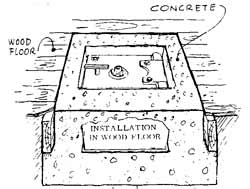
- Measure the dimensions of the safe and mark them on the floor using a pencil or marker.
- Using a circular saw or a reciprocating saw, cut along the marked lines to create the hole for the safe. Make sure to wear protective goggles and gloves while operating the saw.
- Remove the cut section of the floor and set it aside. You may need it later for any repairs or adjustments.
- Inspect the subfloor underneath the cut area to ensure that it is in good condition and free of any obstructions.
- If necessary, reinforce the subfloor by adding additional support beams or plywood to ensure stability and prevent any sinking or sagging.
- Once the subfloor is prepared, place the safe into the cutout hole and check for a snug fit. If needed, make any necessary adjustments to the hole to ensure a proper fit.
- Finally, secure the safe to the floor using the bolts or screws provided by the manufacturer. Make sure the safe is level and securely fastened before proceeding.
By following these steps, you can safely and effectively cut the floor to install your new floor safe.
Creating a Foundation
Before you can install a floor safe, you need to create a solid foundation. This is crucial for ensuring the safe is stable and securely built into the floor.
Here’s a step-by-step guide on how to create a foundation for your floor safe:
- Choose a suitable location: Select a spot in your home or office where you want to install the floor safe. Make sure it’s easily accessible and away from potential hazards or obstructions.
- Prepare the floor: Clean the area where you plan to install the safe. Remove any debris, dust, or loose flooring materials.
- Measure and mark: Use a tape measure and pencil to mark the dimensions of the safe on the floor. Ensure the measurements are accurate and take into account any required clearances.
- Create a cutout: Use a power saw or jackhammer to carefully cut out the marked area on the floor. Follow the manufacturer’s instructions for the safe’s specific dimensions.
- Remove excess debris: Clean up the cutout area, removing any excess concrete, dust, or debris.
- Apply adhesive: Apply a suitable adhesive or epoxy to the bottom of the cutout area. This will help secure the safe in place and prevent it from shifting or moving.
By carefully following these steps, you can create a solid foundation for your floor safe, ensuring it is properly installed and provides maximum security for your valuables.
Placing the Floor Safe
Once you have decided on the perfect location for your floor safe, you can begin the installation process. Here is a step-by-step guide on how to properly place a floor safe:
| Step 1: | Clear the area where you plan to install the floor safe. Make sure there are no obstructions or debris that could interfere with the installation process. |
| Step 2: | Measure the dimensions of the floor safe and mark the location on the floor. Double-check the measurements to ensure that the safe will fit properly. |
| Step 3: | Use a drill to create pilot holes in the marked location. Make sure the holes are evenly spaced and that they match the dimensions of the safe’s anchor points. |
| Step 4: | Insert the anchors into the pilot holes. This will provide extra support and security for the floor safe. |
| Step 5: | Carefully lower the floor safe into the marked location. Make sure it fits securely and is level with the floor surface. |
| Step 6: | Tighten the anchor bolts or screws to secure the floor safe in place. Use a wrench or screwdriver to ensure a tight fit. |
| Step 7: | Test the floor safe to make sure it is functioning properly. Ensure that the locking mechanism is working correctly and that the safe door opens and closes smoothly. |
Following these steps will help ensure that your floor safe is securely and properly placed, providing you with the peace of mind knowing that your valuables are protected.
Securing the Safe
Once you have successfully installed your floor safe, it is important to take the necessary steps to secure it properly. Here’s how:
1. Anchoring: Make sure to anchor the safe securely to the floor. This will prevent any unauthorized persons from easily removing the safe from its position. Use strong bolts or screws that are suitable for the type of flooring you have.
2. Disguise: Consider disguising the safe so that it is not easily noticeable. You can use rugs, furniture, or other objects to camouflage the safe and blend it in with its surroundings. This will make it harder for intruders to locate the safe.
3. Concealment: If possible, try to install the safe in a discreet location where it is less likely to be discovered. Avoid placing it in high-traffic areas or areas that are easily accessible to others. The more hidden the safe is, the better protected it will be.
4. Additional Security Measures: Consider adding additional security measures such as an alarm system or video surveillance to protect the safe and its contents. These measures can act as deterrents and provide an extra level of security.
By following these steps, you can ensure that your floor safe is properly secured and protected from unauthorized access. Remember to regularly check the condition of the safe and its anchoring to maintain its security effectiveness.
Testing the Installation
Once you have successfully installed the floor safe, it is important to test its functionality. Testing the installation ensures that the safe is secure and functioning properly. To test the installation, follow these steps:
1. Close and lock the safe door to ensure that it is fully secured.
2. Try to open the safe using the provided key or combination. Make sure that the lock mechanism is working correctly and that the door opens smoothly.
3. Check for any gaps or spaces around the safe door. There should be no visible openings that could allow for tampering or unauthorized access.
4. Place some lightweight items inside the safe and close the door. Open and close the safe multiple times to ensure that it remains secure and that the items inside do not shift or rattle.
5. Test the floor safe’s resistance to external factors such as water and fire, if applicable. Review the manufacturer’s specifications to determine the safe’s resistance capabilities and perform the necessary tests.
By thoroughly testing the installation, you can have peace of mind knowing that your floor safe is properly installed and functioning as intended.
Final Steps and Maintenance
Once you have successfully installed the floor safe, there are a few final steps to complete the process and ensure proper maintenance.
Firstly, test the door and lock mechanism to make sure they are functioning smoothly. Open and close the safe several times to check for any issues or obstructions. If you notice anything amiss, consult the manufacturer’s instructions or contact a professional for assistance.
Next, consider adding some additional security measures to your floor safe. This could include installing an alarm system or connecting the safe to a home security system. These extra precautions can provide added peace of mind and protect your valuables even further.
Regular maintenance is also crucial to keep your floor safe in optimal condition. Clean the safe periodically with a soft cloth and mild cleaning solution. Avoid using harsh chemicals or abrasive materials that could damage the safe’s surface.
Additionally, check the safe’s seals and gaskets regularly to ensure they are intact and functioning properly. These seals are essential for keeping out moisture and preventing damage to the contents of the safe. If you notice any wear or damage to the seals, replace them promptly to maintain the safe’s effectiveness.
Finally, consider reviewing your insurance coverage to ensure your valuables are adequately protected. While a floor safe can provide excellent security, it’s always a good idea to have additional coverage in case the unexpected happens.
By following these final steps and performing regular maintenance, you can enjoy peace of mind knowing that your valuables are secure in your newly installed floor safe.
Wrapping Up
In conclusion, knowing how to install a floor safe is crucial for ensuring the security of your valuables. By following the step-by-step guide provided above, you can confidently install a floor safe in your desired location. Remember to choose a strong and secure safe that meets your specific needs. Additionally, make sure to measure the space accurately and prepare the area beforehand. Always prioritize safety during the installation process and seek professional help if needed. With the right tools and knowledge, you can successfully install a floor safe and enjoy peace of mind knowing that your belongings are safe and secure.
Q&A:
Why should I install a floor safe?
Installing a floor safe provides an additional layer of security for your valuables and important documents. It can be hidden from view and burglars may not be aware of its presence. This makes it more difficult for them to access and steal your belongings.
What materials do I need to install a floor safe?
To install a floor safe, you will need the following materials: a floor safe, a drill, a hammer, a chisel, a pry bar, concrete or epoxy adhesive, screws, and a level. Additionally, you may need a vacuum cleaner, a broom, and a bucket for cleaning up the debris.
Can I install a floor safe by myself or do I need professional help?
While it is possible to install a floor safe by yourself, it is recommended to seek professional help, especially if you are not experienced in drilling into concrete. Professional installation ensures that the safe is installed securely and correctly, minimizing the risk of damage to your floor or safe.
How deep should the hole be for installing a floor safe?
The depth of the hole for a floor safe depends on the size and specifications of the safe. Generally, the hole should be deep enough to allow the safe to sit flush with the floor. Measure the height of the safe, including any protruding parts, and add a few inches to the measurement to determine the depth of the hole.
Can I install a floor safe on any type of flooring?
A floor safe can be installed on various types of flooring, including concrete, hardwood, and tile. However, it is important to consider the structural integrity of the flooring and whether it can support the weight of the safe. It is recommended to consult a professional to determine the suitability of your flooring for installing a floor safe.
What tools do I need to install a floor safe?
You will need a drill, a hammer, a chisel, a tape measure, a pencil, and a floor safe.


